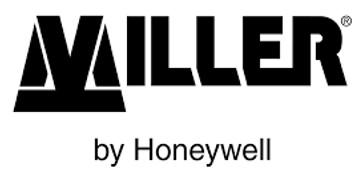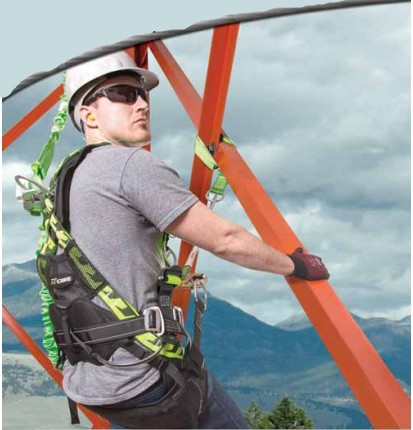Honeywell AAT-QCSMG Miller Aircore Tower CLimbing Harness Instruction Manual


User Instruction Manual Supplement
Download instruction manuals and product specification sheets at: www.millerfallprotection.com.
This AirCore Tower Climbing Harness Supplement must be used in conjunction with the Miller Harnesses and Body Belts User Instruction Manual (I119).
All persons using this equipment must read, understand and follow all instructions. Failure to do so may result in serious injury or death. Do not use this equipment unless you are properly trained.
Purpose
The new Miller AirCore™ Tower Climbing Harness provides the ultimate in performance, comfort, and durability — exceeding expectations when used in even the most challenging climbing environments! This new line of AirCore harnesses keeps your workers comfortable and safe — increasing productivity. It’s designed for workers climbing cell phones, TV, radio, and utility towers, while building/ decommissioning towers, changing out transmission lines/antennas, or installing/replacing lights.
Harness Description and Features
Miller AirCore Tower Climbing Harnesses and Accessories | |
| Model No. | Description |
| ACT-QCUG* | AirCore Harness with stretchable DuraFlex® webbing, back D-ring, combination D-ring pad/shoulder pads, waist belt and lumbar back pad, side positioning D-rings, quick connect chest strap with front D-ring, quick connect leg straps with padding, cam buckle shoulder strap adjustment, two pull-free lanyard rings, two pull-free Velcro keepers, elastic webbing keepers, two tool loops, and mating buckle connectors for attachment of accessories. Includes steel hardware. |
| ACT-QCBCUG* | Same as ACT-QCUG, plus includes Bos’n Chair with steel hardware (ACT-BC). |
| AAT-QCUG* | Same as ACT-QCUG, but made with aluminum hardware. |
| MT-QCBCUG* | Same as ACT-QCUG, but made with aluminum hardware and includes Bos’n Chair with aluminum hardware (MT-BC). |
| ACT-BC | Bos’n Chair with steel mating buckle connectors for attachment to harness, two adjustment straps with clips that attach to harness, and two steel D-rings. |
| MT-BC | Same as ACT-BC, but made with aluminum hardware. |
| ACTL10 | Tool Loops for attachment to harness belt (package of 10). |
* Harnesses are available in two colors: green or blue.
Harnesses are available in Small/Medium (SM), Universal (U), or XXL/XXXL (23X).
Easily visible, color-coded tabs indicate harness sizes.
AirCore Tower Climbing Harness
~Unique Features~
Requirements, Warnings, and Limitations
Users must read, understand and follow all requirements, warnings, and limitations provided in the Miller Harnesses and Body Belts instruction manual (I119) as well as this supplement.
Fall protection connecting devices should be attached to the back D-ring. A front D-ring may be used for fall arrest only in applications where the personal fall arrest system limits the maximum free fall distance to 2 ft. (0.6m) and limits the maximum arrest force to 900 lbs. (4kN), such as climbing applications.
Side D-rings are designed for positioning applications only.
A personal fall arrest system must be in place and connected at all times when the Bos’n chair is in use. The full-body harness must be attached to a lifeline independent of the work line used for suspension.
Bos’n chair D-rings are designed for positioning during suspension work only. Bos’n chair steel or aluminum mating buckle connectors must be properly connected to corresponding mating buckle connections on the harness for use. Adjustment straps with clips also must be attached to the harness, but never use adjustment straps with clips as the only means of attachment to the harness.
Tool loops must only be used for the attachment of light tools and tool bags. Never use tool loops for lanyard storage, fall restraint, or any other purpose for which they were not designed. Always ensure that there is adequate fall clearance for the application.
Harness Preparation
Lay harness on a flat surface with the backside facing up (Fig. 1).
Place the Bos’n chair (Fig. 2) on the harness just below the belt and back pad with the webbing straps facing up and the mating buckle connectors extending toward their corresponding connections on the harness (Fig. 3).
Connect the mating buckle component on the Bos’n chair with its corresponding mating buckle component on the belt as shown (Fig. 4a & 4b).
Repeat for the opposite side.
Then attach each adjustment strap clip on the Bos’n chair with its corresponding clip connection on the harness as shown (Fig. 5a & 5b).
Ensure that webbing straps are not twisted and that buckles and clips are securely and properly connected (Fig. 6).
The Bos’n chair can be adjusted up or down by the user while the user is wearing the harness (Fig. 7).
Simply grasp the free end of the adjustment webbing strap and pull downward to bring the Eios’n chair up or extend the webbing out of the clip (shortening the free end) to the lower Bos’n Chair.
BOS’N CHAIR ADJUSTMENT
Use
Don the harness ensuring that the harness is properly fitted and all buckle connections are secure.
Refer to 1119 – Miller Harnesses and Body Belts instruction manual.
New Cam Buckle Adjustment
- Grasp the loose end of the webbing strap and pull to tighten. Tuck excess webbing into elastic keepers.
- To loosen, press the cam buckle tab outward to release the grip and pull the webbing strap out through the buckle.
Applications (Fig. 8 & 9)
Fall Arrest
A compatible connecting device and anchorage connector/anchorage must always be used in conjunction with the harness to complete the personal fall arrest system and protect the worker from a fall while working at heights. The Bos’n chair is not designed to arrest a fall.
The connecting device must be connected to the back D-ring on the harness. A two-legged shock-absorbing lanyard or dual self-retracting lifeline system is recommended for climbing applications. Alternatively, a fall arrester attached to a vertical climbing system may be connected to the front D-ring on the harness so long as the personal fall arrest system limits the maximum free fall distance to 2 ft. (0.6m) and limits the maximum arrest force to 900 lbs. (4.0kN).
Suspension
For suspension work, connect the Bos’n chair D-rings to an approved, compatible suspension system. A personal fall arrest system must be used in conjunction with the suspension system.
Note: Always read and follow the instructions provided with all system components used in conjunction with the AirCore Tower Harness.
| Fig. 8
|
Fig.9
|
Use of Tool Loops
Tool loops are designed for the convenient attachment of light tools and tool bags (Fig. 10).
Tools must have the means to connect to the loop and should never hang freely without a closed connection.
WARNING: Belt must be properly re-attached to harness, ensuring that all points of attachment have been utilized correctly (see Fig. 1 la, lib & 11c). The belt must go through side D-rings, mating buckles, and back web loop as shown.
| Fig. 11a
|
Fig. 11b
|
Fig. 11c |
Storage of Connecting Device when Not in Use
Attach the connecting device to either the pull-free Velcro® keeper (Fig. 12) or the pull-free lanyard ring (Fig. 13).
Do not attach an unused connecting device to any other components of the harness.
Inspection
Inspect harness, including Bos’n chair, according to the Miller Harness and Body Belts instruction manual. Always inspect for the absence of or alteration to any elements affecting the equipment form, fit or function and check for any indications of damage that may affect the integrity and operation of the product. If in doubt, contact the manufacturer.
Labels | |
Fax: 800.892.4078
Download this manual at: www.millerfallprotection.com
Honeywell Safety Products
P.O. Box 271, 1345 15th Street
Franklin, PA 16323 USA